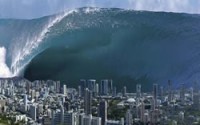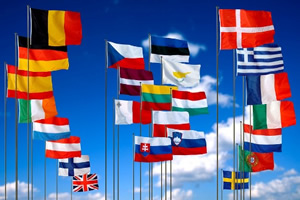English Reading Passage – Pollution
Pollution
Pollution is the introduction of contaminants into the natural environment that cause adverse change. Pollution can take the form of chemical substances or energy, such as noise, heat or light. Pollutants, the components of pollution, can be either foreign substances/energies or naturally occurring contaminants.
Pollution is often classed as point source or nonpoint source pollution. The Blacksmith Institute issues an annual list of the world’s worst polluted places. In the 2007 issues the ten top nominees are located in Azerbaijan, China, India, Peru, Russia, Ukraine and Zambia.
Ancient cultures
Air pollution has always accompanied civilizations. Pollution started from the prehistoric times when man created the first fires. According to a 1983 article in the journal Science, “soot found on ceilings of prehistoric caves provides ample evidence of the high levels of pollution that was associated with inadequate ventilation of open fires.” The forging of metals appears to be a key turning point in the creation of significant air pollution levels outside the home. Core samples of glaciers in Greenland indicate increases in pollution associated with Greek, Roman and Chinese metal production, but at that time the pollution was comparatively less and could be handled by nature.
Official acknowledgement
King Edward I of England banned the burning of sea-coal by proclamation in London in 1272, after its smoke became a problem. But the fuel was so common in England that this earliest of names for it was acquired because it could be carted away from some shores by the wheelbarrow. Air pollution would continue to be a problem in England, especially later during the industrial revolution, and extending into the recent past with the Great Smog of 1952. London also recorded one of the earlier extreme cases of water quality problems with the Great Stink on the Thames of 1858, which led to construction of the London sewerage system soon afterward.
It was the industrial revolution that gave birth to environmental pollution as we know it today. The emergence of great factories and consumption of immense quantities of coal and other fossil fuels gave rise to unprecedented air pollution and the large volume of industrial chemical discharges added to the growing load of untreated human waste. Chicago and Cincinnati were the first two American cities to enact laws ensuring cleaner air in 1881. Other cities followed around the country until early in the 20th century, when the short lived Office of Air Pollution was created under the Department of the Interior. Extreme smog events were experienced by the cities of Los Angeles and Donora, Pennsylvania in the late 1940s, serving as another public reminder.
Modern awareness
Pollution became a popular issue after World War II, due to radioactive fallout from atomic warfare and testing. Then a non-nuclear event, The Great Smog of 1952 in London, killed at least 4000 people. This prompted some of the first major modern environmental legislation, The Clean Air Act of 1956.
Pollution began to draw major public attention in the United States between the mid-1950s and early 1970s, when Congress passed the Noise Control Act, the Clean Air Act, the Clean Water Act and the National Environmental Policy Act.
Severe incidents of pollution helped increase consciousness. PCB dumping in the Hudson River resulted in a ban by the EPA on consumption of its fish in 1974. Long-term dioxin contamination at Love Canal starting in 1947 became a national news story in 1978 and led to the Superfund legislation of 1980. Legal proceedings in the 1990s helped bring to light hexavalent chromium releases in California鈥攖he champions of whose victims became famous. The pollution of industrial land gave rise to the name brownfield, a term now common in city planning.
The development of nuclear science introduced radioactive contamination, which can remain lethally radioactive for hundreds of thousands of years. Lake Karachay, named by the Worldwatch Institute as the “most polluted spot” on earth, served as a disposal site for the Soviet Union throughout the 1950s and 1960s. Second place may go to the area of Chelyabinsk U.S.S.R. (see reference below) as the “Most polluted place on the planet”.
Nuclear weapons continued to be tested in the Cold War, sometimes near inhabited areas, especially in the earlier stages of their development. The toll on the worst-affected populations and the growth since then in understanding about the critical threat to human health posed by radioactivity has also been a prohibitive complication associated with nuclear power. Though extreme care is practiced in that industry, the potential for disaster suggested by incidents such as those at Three Mile Island and Chernobyl pose a lingering specter of public mistrust. One legacy of nuclear testing before most forms were banned has been significantly raised levels of background radiation.
International catastrophes such as the wreck of the Amoco Cadiz oil tanker off the coast of Brittany in 1978 and the Bhopal disaster in 1984 have demonstrated the universality of such events and the scale on which efforts to address them needed to engage. The borderless nature of atmosphere and oceans inevitably resulted in the implication of pollution on a planetary level with the issue of global warming. Most recently the term persistent organic pollutant (POP) has come to describe a group of chemicals such as PBDEs and PFCs among others. Though their effects remain somewhat less well understood owing to a lack of experimental data, they have been detected in various ecological habitats far removed from industrial activity such as the Arctic, demonstrating diffusion and bioaccumulation after only a relatively brief period of widespread use.
Growing evidence of local and global pollution and an increasingly informed public over time have given rise to environmentalism and the environmental movement, which generally seek to limit human impact on the environment.
Warning: Use of undefined constant rand - assumed 'rand' (this will throw an Error in a future version of PHP) in /home/sentence/sinavingilizce.com/wp-content/themes/ribbon/single.php on line 40
Warning: count(): Parameter must be an array or an object that implements Countable in /home/sentence/sinavingilizce.com/wp-includes/class-wp-comment-query.php on line 405




